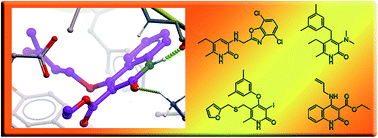Advances in the development of pyridinone derivatives as non-nucleoside reverse transcriptase inhibitors†
Abstract
Non-nucleoside reverse transcriptase inhibitors (NNRTIs) are part of a structurally diverse family with distinct features attractive for the treatment of AIDS that continues to be a major health problem. NNRTIs are highly selective to HIV-1 reverse transcriptase and have, in general, high selectivity and lower toxicity than other anti-AIDS drugs. However, non-optimal pharmaceutical properties and resistance mutations highlight the need to continue identifying and developing novel NNRTIs. Derivatives of pyridin-2(1H)-one are promising NNRTs under pre-clinical development. Herein, we survey the evolution of the pyridin-2(1H)-one class over the past 25 years: from the first generation of compounds with weak inhibitory activities against mutant strains to advanced generations with improved activity profiles against clinically relevant mutants. Crystallographic structures, structure-based and ligand-based computational analysis, and medicinal chemistry efforts have worked in synergy to develop this important chemical class. We also discuss recent trends and future directions that can further improve the activity of pyridin-2(1H)-ones against clinically relevant mutant strains.



 Please wait while we load your content...
Please wait while we load your content...